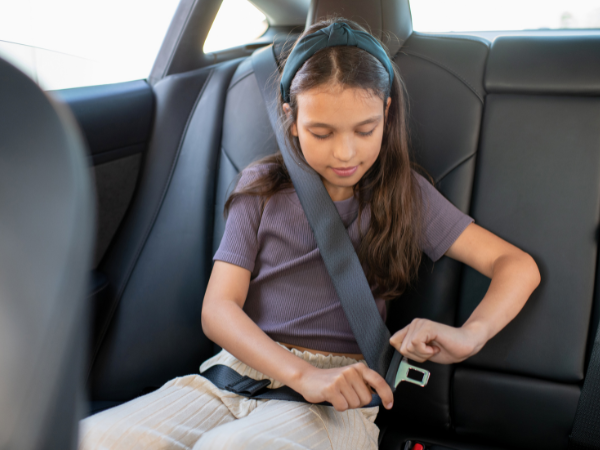This guide will reveal the front seat regulations worldwide, empowering you to make informed choices. It’s crucial for you to know the specific laws to keep your little ones safe and sound. Don’t miss out on essential tips that could make all the difference for you and your family.
Why Front Seat Rules Matter For Kids
When can kids sit in the front seat? The answer varies by country, but the reasoning behind the rules is universal. Front seat rules are designed to keep kids safe from harm, especially from the dangers posed by airbags and the impact of a collision.
Safety First
Safety is the top priority when deciding if a child can sit in the front seat. Cars are equipped with front airbags designed to protect adults in a crash. Front airbags can injure small children, as they deploy with great force. For a child, this impact can cause severe injury or even be fatal.
The rear seats are inherently safer for young passengers. Rear seats reduce the risk of serious injury in accidents. In addition to the seat location, using proper restraint systems is crucial. Car seats and boosters add needed protection by securing the child and distributing crash forces more evenly across their body.
Let’s look at some safety considerations:
- Always use age-appropriate car seats or booster seats.
- Ensure that the seatbelt fits properly over the child’s shoulders and hips.
- Follow manufacturer guidelines for car seat installation and usage.
Statistics show that children in rear seats with proper restraints are less likely to suffer serious injuries. Therefore, parents should focus on these safety measures to protect their young ones.
Legal Vs. Recommended Guidelines
Each country has its own legal requirements for children sitting in the front seat, but these laws can differ from safety recommendations. Many countries follow WHO or local pediatric advice for setting these guidelines. Age and height limits differ from legal minimums, highlighting the gap between what is legal and what is considered safe.
In some regions, laws may permit children as young as 12 to sit in the front seat. Laws may allow it – but safety guidelines advise against it for children under a certain height or weight. Safety experts often suggest that children remain in the rear seats until they are older and bigger, even if the law says otherwise.
Here’s a comparison:
| Country | Legal Age | Recommended Age |
|---|---|---|
| United States | 12 years | 13 years or older |
| United Kingdom | 12 years or 135 cm | Rear seat as long as possible |
| Australia | 7 years | 12 years or older |
Parents should strive to follow safety recommendations over legal minimums. This ensures children are protected by the latest safety research and best practices. Always check the most current guidelines for your region and adhere to them for your child’s safety.
Country-by-country Front Kids Seat Laws
Each country has unique laws regarding children sitting in the front seat of a car. These laws ensure safety and vary based on age, height, and available restraints.

United States
In the United States, it’s recommended that children sit in the back seat until they reach age 13. However, state laws vary, often requiring booster seats until a child is between 8 to 12 years old.
- Recommended: back seat until age 13
- State laws vary (usually booster seats until age 8–12)
For a detailed understanding, parents can refer to the table below that highlights age and seat recommendations:
| Age | Seat Recommendation |
|---|---|
| Under 8 | Booster seat |
| 8-12 | Back seat recommended |
| 13+ | Front seat allowed |
This variation means parents must check specific state requirements.
United Kingdom
In the United Kingdom, children from 12 years old can legally sit in the front seat provided they have an appropriate car seat. It’s mandatory for children under 135 cm to use a booster or child seat regardless of where they sit in the vehicle.
- Legal: front seat permitted with appropriate car seat
- Children under 135 cm must use booster or child seat
This law ensures that children are safely restrained, minimizing the risk of injury during travel.
France
French law dictates that children under 10 years old must sit in the back seat. They can sit in the front seat only if they are properly restrained. This rule aims to enhance child safety by restricting front seat access.
- Children under 10 years old must sit in the back
- Front seat allowed only with proper restraint
Ensuring proper restraint in the front seat is crucial for compliance with French safety standards.
Australia
Australia imposes strict rules for children sitting in the front seat. Children under 4 years are banned from sitting in the front. Those aged 4 to 7 can sit in the front only if the back seats are fully occupied.
- Under 4 years: front seat banned
- Ages 4–7: front seat only if back is fully occupied
These regulations prioritize child safety by encouraging the use of back seats for younger passengers.
Canada
Canada recommends that children sit in the back seat until age 13. Provincial laws may differ, generally requiring booster seats until a child is between 8 to 9 years old.
- Recommended: back seat until age 13
- Laws differ by province – generally booster until age 8–9
Parents are advised to check provincial regulations to ensure they follow the correct guidelines for child passenger safety.
Germany
In Germany, children under 12 years or shorter than 150 cm must use a restraint system. They can sit in the front seat if a proper child seat is utilized.
- Children under 12 years or <150 cm: must use restraint
- Front seat allowed if proper child seat used
This law aims to maintain high safety standards by ensuring children are adequately secured in vehicles.
Japan
Japanese law requires a child restraint for children under 6 years old. They can sit in the front seat if this restraint is used.
- Child restraint required for under 6 years old
- Front seat use permitted if restraint is used
Parents must ensure that restraints meet safety standards to protect young passengers.
Philippines
In the Philippines, children under 12 years and shorter than 150 cm are banned from sitting in the front seat. Exceptions are made only if no rear seats exist in the vehicle.
- Kids under 12 years and under 150 cm banned from front seat
- Exceptions only if no rear seats exist
This law is designed to maximize child safety by ensuring they remain in the back seat when possible.
Vietnam
Vietnam plans to enforce new laws effective January 2026. Children under 10 years or shorter than 1.35 meters will be banned from the front seat, with exceptions for vehicles without rear seats.
- Children under 10 years or <1.35 meters banned from front seat
- Exceptions for vehicles without rear seats
These upcoming regulations reflect Vietnam’s commitment to enhancing vehicle safety for children.
Ukraine
In Ukraine, children under 150 cm must use a restraint system. The front seat is permitted only for rear-facing car seats, provided the airbag is off.
- Kids under 150 cm must use restraint system
- Front seat allowed for rear-facing car seat only with airbag off
These regulations ensure that young passengers are secured safely during transit.
Key Age & Height Milestones
Most countries use age and height as guidelines to determine if a child can sit in the front seat. These milestones help ensure that children are adequately protected by the vehicle’s safety features.
Common Thresholds
Each country has specific laws regarding the age and height at which children can sit in the front seat. In many countries, the common threshold for allowing kids in the front seat is between ages 10–13. This range considers the development of a child’s body to withstand the impact of a crash.
Height is another crucial factor. Most countries require a height of 135–150 cm for kids to sit in the front seat safely. This height ensures that the seat belt fits properly across the chest and not the neck.
Booster seats are typically needed until children are between 8–12 years old. These seats help position the seat belt correctly, providing additional safety. Always check local laws and regulations to ensure compliance with these guidelines.
Airbag Considerations
Airbags are designed for adults and can be dangerous for children. The combination of rear-facing seats + airbags can cause serious injury in a collision. In some countries, laws require the deactivation of airbags if a child must sit in the front seat.
Here are some key considerations for airbags:
- Rear-facing child seats should never be placed in front of an active airbag.
- If a child must sit in the front seat, consider deactivating the airbag.
- Many vehicles have an airbag deactivation switch; consult your vehicle’s manual.
Deactivation may be legally required in some areas for the safety of young passengers. Always consult your vehicle manual and local laws to understand the requirements in your region. Ensuring that these safety measures are in place helps protect children from potential harm.





Leave a Reply